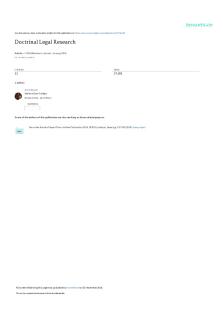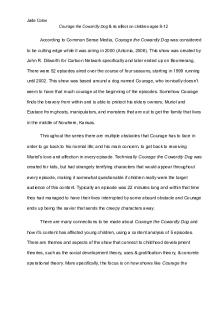Research & Media Final - Eyesight and Intellect PDF

| Title | Research & Media Final - Eyesight and Intellect |
|---|---|
| Course | Introduction To Psychology |
| Institution | Northern Arizona University |
| Pages | 6 |
| File Size | 107.2 KB |
| File Type | |
| Total Downloads | 30 |
| Total Views | 130 |
Summary
Assignment: Reasearch a topic manipulated by the media, include references and a one page reflection, ...
Description
1 Research & Media Final Eyesight & Intellect Eight Fact Psychology states that “poor eyesight (myopia) is associated with higher I.Q.”, however, the epidemiology behind myopia and the abilities behind I.Q. do not support this claim. Myopia, according to the Merriam- Webster Dictionary, is “a condition in which the visual images come to a focus in front of the retina of the eye resulting especially in defective vision of distant objects”, in more simple terms, nearsightedness. This became an interesting topic to look at because there is a stigma behind individuals that wear glasses, saying that those who have poor eyesight are smarter than those who’s eyesight is fine. In finding my peer reviewed articles, I searched through the Cline Library’s resources. Several of the sources provided wouldn’t load properly or asked me to purchase them however, I came across two that I could use to question the 8fact claim. I choose to research this claim through two routes, one being through the epidemiology behind myopia, and through the definition and explanation of the Intelligence Quotient. In the research on Myopia by Ian G. Morgan, Kyoko Ohno- Matsui, and Seang- Mei Saw, there are two major factors that challenge 8fact’s claim, the epidemiology and the environmental risk factors of myopia. Through research in both Taiwan and young adults of Chinese ancestry, they found that the cultural differences in the prevalence of myopia is not a genetic factor, but more of an environmental situation. They found that there is a lower prevalence of myopia in rural areas than in urban areas; for example, there is more cases of myopia in the USA and UK than in middle Eastern children and those of sub-Saharan African ancestry. They note that the prevalence in myopia has increased in just about every culture, but that is due to social environmental factors. They state that the prevalence of myopia is not so much due to genetic
2 ancestry, but more so due to where the individual grows up and the environment in which they are exposed to. Focusing back to 8fact’s claim, they state that myopia is about high intelligence, and this research articles explores that idea, and they do find correlation, however they explain just why that correlation exists. In the article, they address that myopia and the results of years of schooling have been reported time and time again, however they attribute that to the intensity of schooling done around the world, they note that the rise in myopia in urban east Asia may be contributed to the intensity of education and how they also dominate both myopia prominence and international rankings of educational performance. They bring up two different studies, in Singapore and Sydney, to back up this claim. They claim that “increase accommodation due to intensive near work, such as reading and writing, could mediate the association of myopia with schooling” (1741), contributing intensive work to an increase of myopia. In Singapore, they found that children who read less that two books per week have notably lower myopia than children that read two or more books, who were reported to have high myopia. The Sydney Myopia Study approached the idea slightly differently, and didn’t contribute myopia to the amount of intensive work done, but contributed it to how close children read to their face, finding that children who continuously read at a close distance were more likely to be myopic. In conclusion, Ian G. Morgan, Kyoko Ohno- Matsui, and Seang- Mei Saw, found that the intensity of near work leads to “hyperopic defocus on the retina” causing myopia. In a way, 8fact is correct, myopia does correlate with intelligence, however, those with myopia aren’t intelligent because of it, but because of the intense studying done close to the face. Myopia isn’t an indicator of intelligence and those that are intelligent don’t always suffer from myopia. The correlation between intellect and myopia does not mean that one causes the other.
3 In Conventional Intelligence Measurments and Neuropsychology Concepts of Adaptive Abilities by Ralph H. Reitan and Deborah Wolfson, they explore which factors determine intelligence. They consider many ideas of how intellect may be defined, one being by Stoddard in his book, The Meaning of Intelligence, in which they break it down into five parts, difficulty, complexity, abstractness, economy, adaptiveness to a goal, social value, and “the emergence of originals and to maintain such activities under conditions that demand a concentration of energy and a resistance to emotional forces” (522). Boring (1992), thought that intelligence must be defined as someone’s ability to do well on a test that is meant to measure intelligence. While others like Hebb (1949) and Neisser (1979) thought intelligence was almost impossible to measure and define. There were even different ideas of how intelligence should be measured, like Gardner (1985), who said that when measuring intelligence, different abilities should be measure, for example music and art ability. Sternberg (1982, 1985) suggested that intellect is broken in to three abilities which he calls the triarchic theory. The triarchic theory involves the relationship between intelligence and (1) the individual’s world, (2) the external world, and (3) the relationship it plays with experience, in which he concludes that “intelligence is expressed in terms of adaptive, goal directed behavior” (523). What all of these ideas have in common is ability, and none suggest that there is some sort of biological factor, like myopia, that determines intellect, making it a one-way argument. Morgan. Ohno-Matsui, and Saw, wouldn’t have referred to myopia as a major health concern (1739) if it were to cause higher intelligence, and there would be some biological evidence if myopia caused intelligence. Despite the fact that there are some correlations between individuals who are more academically successful and myopia, it has nothing to do with I.Q., and is essentially dependent on the individuals work ethic and style, not their overall intelligence.
4 Research & Media Final Resources
8Fact / Google
https://www.google.com/search? q=8fact+myopia&safe=active&client=safari&rls=en&source=lnms&tbm=isch&sa=X&v ed=0ahUKEwjb9brB1PjXAhUO24MKHSimBNQQ_AUICigB&biw=1280&bih=739#im grc=8l4H4SuF-fkmwM:
Conventional Intelligence Measurements and Neuropsychology Concepts of Adaptive Abilities / EBSCOhost
http://libproxy.nau.edu/login?url=http://search.ebscohost.com/login.aspx? direct=true&db=a9h&AN=9302070313&site=ehost-live&scope=site
Myopia / NAU Cline Library
https://www.sciencedirect.com/science/article/pii/S0140673612602724
5
Research & Media Final Reflection Other than the information I learned in the research articles, one of the most important things I learned was to think critically about information that is presented, and that it is also important to consider the resources and the evidence behind what is being said. With the news playing such a large part in how we receive our information and with social media being so prevalent in our society, it’s easy to be fed information that isn’t exactly true and that can cause a lot of issues in how we see the world around us. I think that the Research and Media papers were extremely beneficial during the semester, because I learned how to evaluate information, how to read research articles, and how to apply what I had just learned to what I know, and this is a transferrable trait in which I can take to my other classes and use through my college education. One thing I do want to note about this paper specifically, is that I was ready to say that 8fact was completely incorrect and that in no way was there any correlation, but as I read the research article, I was in somewhat of a shock. The article did in fact support the claim of 8fact, there is some sort of association, yet it was still incorrect. I figured out that it’s not necessarily about what it says, but more of how we interpret the information being presented to us. This is where the idea of correlation not being causation comes to play. An increase of myopia does correlate with higher intelligence, but how its read is that myopia causes intelligence, which it does not. And from this I learned that it is important to take what you are reading and to understand it in the sense that it is being presented and to not assume anything else. It’s not just with media claims that this is a problem, it’s with essentially everything we come across. That is
6 another reason I found these projects to be so useful, because you can take what you learn from them and apply it everywhere, and you learn some useful facts....
Similar Free PDFs

Research and Media Assignment #3
- 5 Pages

FINAL FINAL RESEARCH PAPER (1)
- 90 Pages

Media Analysis final - English
- 4 Pages

Media Final Project
- 8 Pages

MKT Research Final Paper
- 4 Pages

ARTH207 Final Research Paper
- 11 Pages

Agrium final research project
- 24 Pages

Doctrinal Legal Research Final
- 17 Pages

Mythology Final Research Paper
- 6 Pages

Research Paper Final
- 10 Pages

Final Research Report
- 18 Pages

Research paper final draft
- 4 Pages
Popular Institutions
- Tinajero National High School - Annex
- Politeknik Caltex Riau
- Yokohama City University
- SGT University
- University of Al-Qadisiyah
- Divine Word College of Vigan
- Techniek College Rotterdam
- Universidade de Santiago
- Universiti Teknologi MARA Cawangan Johor Kampus Pasir Gudang
- Poltekkes Kemenkes Yogyakarta
- Baguio City National High School
- Colegio san marcos
- preparatoria uno
- Centro de Bachillerato Tecnológico Industrial y de Servicios No. 107
- Dalian Maritime University
- Quang Trung Secondary School
- Colegio Tecnológico en Informática
- Corporación Regional de Educación Superior
- Grupo CEDVA
- Dar Al Uloom University
- Centro de Estudios Preuniversitarios de la Universidad Nacional de Ingeniería
- 上智大学
- Aakash International School, Nuna Majara
- San Felipe Neri Catholic School
- Kang Chiao International School - New Taipei City
- Misamis Occidental National High School
- Institución Educativa Escuela Normal Juan Ladrilleros
- Kolehiyo ng Pantukan
- Batanes State College
- Instituto Continental
- Sekolah Menengah Kejuruan Kesehatan Kaltara (Tarakan)
- Colegio de La Inmaculada Concepcion - Cebu



